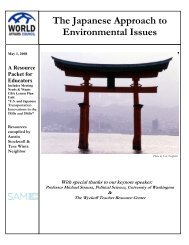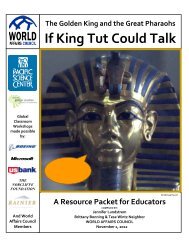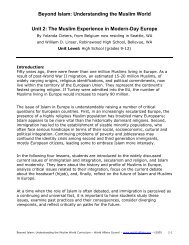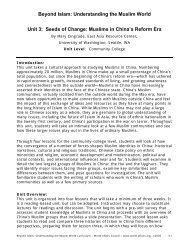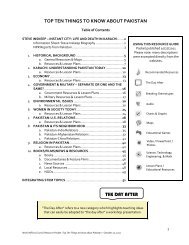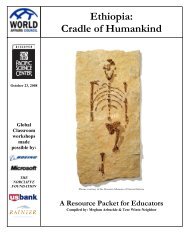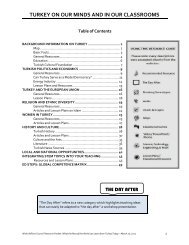The Question(s) of Tibet - World Affairs Council
The Question(s) of Tibet - World Affairs Council
The Question(s) of Tibet - World Affairs Council
You also want an ePaper? Increase the reach of your titles
YUMPU automatically turns print PDFs into web optimized ePapers that Google loves.
MAPS/STATISTICS/TIMELINE<br />
Timeline<br />
7th‐9th century ‐ Namri Songzen and descendants begin to unify <strong>Tibet</strong>an‐inhabited areas and conquer<br />
neighboring territories, in competition with China.<br />
822 ‐ Peace treaty with China delineates borders.<br />
1244 ‐ Mongols conquer <strong>Tibet</strong>. <strong>Tibet</strong> enjoys considerable autonomy under Yuan Dynasty.<br />
1598 ‐ Mongol Altan Khan makes high lama Sonam Gyatso first Dalai Lama.<br />
1630s‐1717 ‐ <strong>Tibet</strong> involved in power struggles between Manchu and Mongol factions in China.<br />
1624 ‐ First European contact as <strong>Tibet</strong>ans allow Portuguese missionaries to open church. Expelled at lama's<br />
insistence in 1745.<br />
1717 ‐ Dzungar Mongols conquer <strong>Tibet</strong> and sack Lhasa. Chinese Emperor Kangxi eventually ousts them in 1720,<br />
and re‐establishes rule <strong>of</strong> Dalai Lama.<br />
1724 ‐ Chinese Manchu (Qing) dynasty appoints resident commissioner to run <strong>Tibet</strong>, annexes parts <strong>of</strong> historic<br />
Kham and Amdo provinces.<br />
1750 ‐ Rebellion against Chinese commissioners quelled by Chinese army, which keeps 2,000‐strong garrison in<br />
Lhasa. Dalai Lama government appointed to run daily administration under supervision <strong>of</strong> commissioner.<br />
1774 ‐ British East India Company agent George Bogle visits to assess trade possibilities.<br />
1788 and 1791 ‐ China sends troops to expel Nepalese invaders.<br />
1793 ‐ China decrees its commissioners in Lhasa to supervise selection <strong>of</strong> Dalai and other senior lamas.<br />
Foreigners banned<br />
1850s ‐ Russian and British rivalry for control <strong>of</strong> Central Asia prompts <strong>Tibet</strong>an government to ban all foreigners.<br />
1865 ‐ Britain starts discreetly mapping <strong>Tibet</strong>.<br />
1904 ‐ Dalai Lama flees British military expedition under Colonel Francis Younghusband. Britain forces <strong>Tibet</strong> to<br />
sign trading agreement in order to forestall any Russian overtures.<br />
1906 ‐ British‐Chinese Convention <strong>of</strong> 1906 confirms 1904 agreement, pledges Britain not to annex or interfere in<br />
<strong>Tibet</strong> in return for indemnity from Chinese government.<br />
1907 ‐ Britain and Russia acknowledge Chinese suzerainty over <strong>Tibet</strong>.<br />
1908‐09 ‐ China restores Dalai Lama, who flees to India as China sends in army to control his government.<br />
1912 April ‐ Chinese garrison surrenders to <strong>Tibet</strong>an authorities after Chinese Republic declared.<br />
Independence declared<br />
1912 ‐ 13th Dalai Lama returns from India, Chinese troops leave.<br />
1913 ‐ <strong>Tibet</strong> reasserts independence after decades <strong>of</strong> rebuffing attempts by Britain and China.<br />
1935 ‐ <strong>The</strong> infant who will later become the 14th Dalai Lama is born to a peasant family in a small village in northeastern<br />
<strong>Tibet</strong>. Buddhist <strong>of</strong>ficials declare him to be the reincarnation <strong>of</strong> the 13 previous Dalai Lamas.<br />
1949 ‐ Mao Zedong proclaims the founding <strong>of</strong> the People's Republic <strong>of</strong> China and threatens <strong>Tibet</strong> with<br />
"liberation."<br />
1950 ‐ China enforces a long‐held claim to <strong>Tibet</strong>. <strong>The</strong> Dalai Lama, now aged 15, <strong>of</strong>ficially becomes head <strong>of</strong> state.<br />
1951 ‐ <strong>Tibet</strong>an leaders are forced to sign a treaty dictated by China. <strong>The</strong> treaty, known as the "Seventeen Point<br />
Agreement," pr<strong>of</strong>esses to guarantee <strong>Tibet</strong>an autonomy and to respect the Buddhist religion, but also allows the<br />
establishment <strong>of</strong> Chinese civil and military headquarters at Lhasa.<br />
Mid‐1950s ‐ Mounting resentment against Chinese rule leads to outbreaks <strong>of</strong> armed resistance.<br />
1954 ‐ <strong>The</strong> Dalai Lama visits Beijing for talks with Mao, but China still fails to honor the Seventeen Point<br />
Agreement.<br />
Revolt<br />
1959 March ‐ Full‐scale uprising breaks out in Lhasa. Thousands are said to have died during the suppression <strong>of</strong><br />
the revolt. <strong>The</strong> Dalai Lama flees to northern India, to be followed by some 80,000 other <strong>Tibet</strong>ans.<br />
1963 ‐ Foreign visitors are banned from <strong>Tibet</strong>.<br />
1965 ‐ Chinese government establishes <strong>Tibet</strong>an Autonomous Region (TAR).<br />
1966 ‐ <strong>The</strong> Cultural Revolution reaches <strong>Tibet</strong> and results in the destruction <strong>of</strong> a large number <strong>of</strong> monasteries and<br />
cultural artifacts.<br />
1971 ‐ Foreign visitors are again allowed to enter the country.<br />
Late 1970s ‐ End <strong>of</strong> Cultural Revolution leads to some easing <strong>of</strong> repression, though large‐scale relocation <strong>of</strong> Han<br />
Chinese into <strong>Tibet</strong> continues.<br />
1980s ‐ China introduces "Open Door" reforms and boosts investment while resisting any move towards greater<br />
autonomy for <strong>Tibet</strong>.<br />
1987 ‐ <strong>The</strong> Dalai Lama calls for the establishment <strong>of</strong> <strong>Tibet</strong> as a zone <strong>of</strong> peace and continues to seek dialogue with<br />
China, with the aim <strong>of</strong> achieving genuine self‐rule for <strong>Tibet</strong> within China.<br />
1988 ‐ China imposes martial law after riots break out.<br />
<strong>World</strong> <strong>Affairs</strong> <strong>Council</strong> Teacher Resource Packet – <strong>The</strong> <strong>Question</strong>(s) <strong>of</strong> <strong>Tibet</strong> February 28, 2011<br />
6



